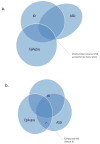Epilepsy and autism: is there a special relationship?
- PMID: 22381386
- PMCID: PMC3307824
- DOI: 10.1016/j.yebeh.2012.01.015
Epilepsy and autism: is there a special relationship?
Abstract
Increasingly, there has been an interest in the association between epilepsy and autism. The high frequency of autism in some of the early-onset developmental encephalopathic epilepsies is frequently cited as evidence of the relationship between autism and epilepsy. While these specific forms of epilepsy carry a higher-than-expected risk of autism, most, if not all, of the association may be due to intellectual disability (ID). The high prevalence of interictal EEG discharges in children with autism is also cited as further evidence although errors in the diagnosis of epilepsy seem to account for at least part of those findings. The prevalence of ID is substantially elevated in children with either epilepsy or autism. In the absence of ID, there is little evidence of a substantial, if any, increased risk of autism in children with epilepsy. Further, although the reported prevalence of autism has increased over the last several years, much of this increase may be attributable to changes in diagnostic practices, conceptualization of autism in the presence of ID, and laws requiring provision of services for children with autism. In the context of these temporal trends, any further efforts to tease apart the relationships between epilepsy, ID, and autism will have to address head-on the accuracy of diagnosis of all three conditions before we can determine whether there is, indeed, a special relationship between autism and epilepsy.
Copyright © 2012 Elsevier Inc. All rights reserved.
Figures

References
-
- Brooks-Kayal A. Epilepsy and autism spectrum disorders: are there common developmental mechanisms? Brain Dev. 2010;32(9):731–8. - PubMed
-
- Besag FM. The relationship between epilepsy and autism: a continuing debate. Acta Paediatr. 2009;98(4):618–20. - PubMed
-
- Levisohn PM. The autism-epilepsy connection. Epilepsia. 2007;48(Suppl 9):33–5. - PubMed
-
- Tuchman R, Alessandri M, Cuccaro M. Autism spectrum disorders and epilepsy: moving towards a comprehensive approach to treatment. Brain Dev. 2010;32(9):719–30. - PubMed

